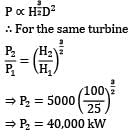Test: Hydraulic Machines Level - 1 - Civil Engineering (CE) MCQ
20 Questions MCQ Test - Test: Hydraulic Machines Level - 1
A Pelton wheel turbine operates under a head of 125 m at a speed of 2000 rpm. To operate very close to the maximum efficiency, the mean diameter of the Pelton wheel is nearly
If D is the diameter of impeller at inlet, w is the width of impeller at inlet and Vf is the velocity of flow at inlet, then discharge through a centrifugal pump is equal to
A jet of water issues from a nozzle with a velocity 20 m ⁄ s on a flat plate moving away from it at 10 m ⁄ s. The cross-sectional area of the jet is 0.01 m2 and the density of water = 1000 kg⁄m3. The force developed on the plate is
A Francis turbine running at 200 rpm develops a power of 5000 kW under a head of 25 m. The power output under a head of 100 m will be
A centrifugal compressor is suitable for which of the following?
A turbine develops 500 kW power under a head of 100 m at 200 rpm. What would be its speed under a head of 81 m?
Match List-I with List-II and select the correct answer
List-I List-II
a. Pelton wheel (single jet) 1. Medium discharge, low head
b. Francis Turbine 2. High discharge, low head
c. Kaplan Turbine 3. Medium discharge, medium head
4. Low discharge, high head
Codes: a b c
Pick up the incorrect statement for centrifugal pumps.
Formation and collapse of vapour bubbles are believed to be the root cause for cavitation in hydraulic turbines. Most favorable condition for the formation of bubbles is set in the turbines at
The correct sequence of the centrifugal pump components through which the fluid flow is
For a reciprocating water pump having cylinder diameter d and crank radius r, if W is the weight of water lifted, the coefficient of discharge is
Both pressure and velocity of steam drops in the moving blades of
A pump running at 1000 rpm consumes 1 kW and generates a head of 10 m of water. When it is operated at 2000 rpm, its power consumption and head generated would be
Which one of the following is impulse turbine?
The specific speed of a turbine is the speed of an imaginary turbine, identical with the given turbine, which
The specific speed of a pump is defined as the speed of the unit of such a size that it
Consider the following statements:
1. The wheel can be operated freely in air
2. Pressure at the exit of the nozzle is atmospheric
3. Pressure does not vary along the moving vanes
4. Change in direction of momentum imparts thrust over moving vanes
Which of the above statements are applied to impulse turbine?
























